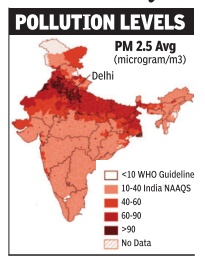 New Delhi / A new study has concluded that as many as 660 million people, or half of India’s population, could add 3.2 years to their lifespan if air quality met the national safe standard. In other words, compliance with standards can save up to 2.1 billion life years in India.
New Delhi / A new study has concluded that as many as 660 million people, or half of India’s population, could add 3.2 years to their lifespan if air quality met the national safe standard. In other words, compliance with standards can save up to 2.1 billion life years in India.
Authored by Michael Greenstone, director of Energy Policy Institute at Chicago, with prominent economists and public policy experts from Yale and Harvard University , the study looks at air quality data in different parts of the country from pollution control boards and satellite data.
The study using the 2011 census data estimates that 660 million people (54.5% of the population) live in regions that do not meet the annual PM 2.5 (particulate matter) standard of 40 microgramme per cubic metre, and 262 million people (21.7% of the population) live in regions with air pollution levels more than twice this standard.
Nearly every Indian (1,204 million people, or 99.5% of the population) lives in an area with PM 2.5 pollution level, much above the WHO’s 10 microgramme per cubic metre guideline.
The study arrived at the life expectancy figures using a study by Greenstone conducted in China which had inferred that with every additional 100 micrograms of total suspended particulate (TSP) matter per cubic meter, life expectancy at birth was lowered by 3 years.
The same metric was applied to Indian data of PM 2.5 levels for this study. Michael Greenstone said, “The study shows that air pollution retards growth by causing people to die prematurely . Other studies have shown that air pollution reduces productivity at work, increases incidence of sick days, and raises health care expenses.“
The authors recommend three policy measures for the Indian government. The first is to increase real-time air quality monitoring stations. It cites Beijing, which has 35 monitoring stations.Kolkata, the Indian city with the maximum stations, has only 20.
The second intervention they recommend is to rely on civil instead of criminal penalties to “instill a polluter pays“ system.
Thirdly , they recommend market-based mechanisms for environmental regulation like the emissions trading system (ETS).

